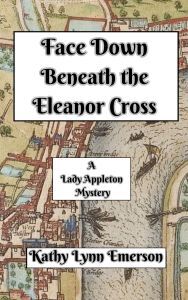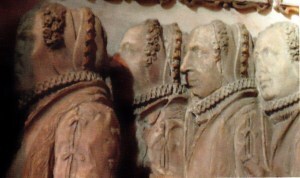Story and Structure
 Kaitlyn Dunnett/Kathy Lynn Emerson here, today writing as Kathy. As I’ve mentioned before here at Maine Crime Writers, I’m in the process of editing and reissuing my Face Down mystery series, ten novels originally published between 1997 and 2007. They feature Susanna, Lady Appleton, a sixteenth-century gentlewoman who just happens to be an expert on poisonous herbs.
Kaitlyn Dunnett/Kathy Lynn Emerson here, today writing as Kathy. As I’ve mentioned before here at Maine Crime Writers, I’m in the process of editing and reissuing my Face Down mystery series, ten novels originally published between 1997 and 2007. They feature Susanna, Lady Appleton, a sixteenth-century gentlewoman who just happens to be an expert on poisonous herbs.
This is actually the second edit I’ve done on these texts. The first was for a three volume e-book collection of all the novels and short stories in the series. Although I haven’t changed the plots or characters, I keep finding plenty of places that need tweaking and/or cutting. Much of what I’ve done is to remove cumbersome language, since I’ve realized that using words like ’tis and certes don’t really give the dialogue “the flavor of the times,” but rather start to grate on the reader’s nerves—at least on this reader’s nerves. I’m also changing phrases like “I do think” to the simpler “I think” and although I know contractions were not in general use in the sixteenth century, I’m letting most of those stand. Worse problems are solved by making judicious cuts. Twenty or so years ago I was wordy (probably trying to make a pre-set word count!) and dialogue between characters didn’t always proceed in a logical fashion. Real-life conversations don’t, either, but in fiction it helps if characters’ thoughts don’t jump around quite so flagrantly.
That said, today’s topic isn’t language or syntax, but rather story and structure. Doing these revisions reminded me of the goals I had when I set out to write historical mysteries set in the sixteenth century.
I knew from the start that there was one thing I wanted to avoid. I did not want the books to be set at the royal court. This proved a wise choice, since two other series were launched at about the same time as mine, one featuring Queen Elizabeth I as an amateur sleuth and the other with a heroine who had close ties to the court. It is book eight, the one I’m currently editing, before Susanna Appleton actually visits the court, and the plot centers around her heartfelt desire not to host the queen at Leigh Abbey, the Appleton manor in Kent, when Elizabeth makes her annual progress into the countryside.

detail of monument to the Cooke sisters
What did I set out to do? A better question would be: what were my inspirations? Susanna herself was inspired by the lives of the five Cooke sisters. Their father educated his daughters as if they were boys (following the example of Sir Thomas More and others) and four of them grew up to marry prominent men and attain fame in their own right for their scholarship. Educated women were not all that rare in sixteenth-century England. (Read my A Who’s Who of Tudor Women if you want to know more) Susanna is literate and clever and developed an interest in poisonous plants—and preventing accidental poisonings—in childhood, after her younger sister died from eating banewort berries. Like one of the Cooke sisters, she marries a gentleman who has been knighted, making her Lady Appleton (see my previous blog on the subject of forms of address). She’s not royal, or even noble—just the daughter and wife of gentlemen. She copes as I imagine someone of her social standing would cope, given that she keeps encountering victims of murder.
 The conflict (a necessity in any story—right?) between Susanna and her husband, Sir Robert, was inspired by Beatrice and Benedict in Shakespeare’s Much Ado About Nothing, although Susanna and Robert’s relationship doesn’t end as well. I was student director for a production of that play in college and knew it well. That’s possibly where some of the pseudo-Shakespearean language in the original text of the first book, Face Down in the Marrow-Bone Pie, originated. As for Robert, he has a lot of secrets, some to do with his family’s background and others because of his work as an “intelligence gatherer.” I don’t usually use actors or characters in films as my inspiration for my characters, but in Robert’s case, after I saw Shakespeare in Love, I always envisioned him as a clone of Colin Firth’s not-very-nice-at-all Earl of Wessex.
The conflict (a necessity in any story—right?) between Susanna and her husband, Sir Robert, was inspired by Beatrice and Benedict in Shakespeare’s Much Ado About Nothing, although Susanna and Robert’s relationship doesn’t end as well. I was student director for a production of that play in college and knew it well. That’s possibly where some of the pseudo-Shakespearean language in the original text of the first book, Face Down in the Marrow-Bone Pie, originated. As for Robert, he has a lot of secrets, some to do with his family’s background and others because of his work as an “intelligence gatherer.” I don’t usually use actors or characters in films as my inspiration for my characters, but in Robert’s case, after I saw Shakespeare in Love, I always envisioned him as a clone of Colin Firth’s not-very-nice-at-all Earl of Wessex.
Looking back on my early plotting (such as it was—I’m not one for planning very far ahead in a story), I have to credit one more influence. In the 1990s, one of the most prominent writers of historical mysteries was Ellis Peters. Her amateur sleuth, Cadfael, knew his herbs, but that wasn’t my takeaway from reading the series. Almost every Cadfael mystery (possibly all of them) have a subplot that involves the romance of two characters Cadfael befriends.
Story and structure? The Face Down novels are murder mysteries, usually featuring domestic murders, but my intention with each novel was to have two subplots, one to do with spies or treason or rebellion—something beyond the purely domestic realm—and the other a romance between secondary characters.
And yes, I always intended to kill off Sir Robert, having first made readers glad to see him get his just desserts. And no, Susanna was never meant to remarry, since to do so would have made her, legally, nothing more than one of her husband’s possessions—a state any sensible widow would want to avoid. Face Down Beneath the Eleanor Cross, in which Robert is the victim and Susanna the prime suspect in his murder, will be released in trade paperback on July 11.

Kathy Lynn Emerson/Kaitlyn Dunnett has had sixty-four books traditionally published and has self published others. She won the Agatha Award and was an Anthony and Macavity finalist for best mystery nonfiction of 2008 for How to Write Killer Historical Mysteries and was an Agatha Award finalist in 2015 in the best mystery short story category. In 2023 she won the Lea Wait Award for “excellence and achievement” from the Maine Writers and Publishers Alliance. She was the Malice Domestic Guest of Honor in 2014. She is currently working on creating new omnibus e-book editions of her backlist titles. Her website is www.KathyLynnEmerson.com.
Lea Wait's Blog
- Lea Wait's profile
- 506 followers



